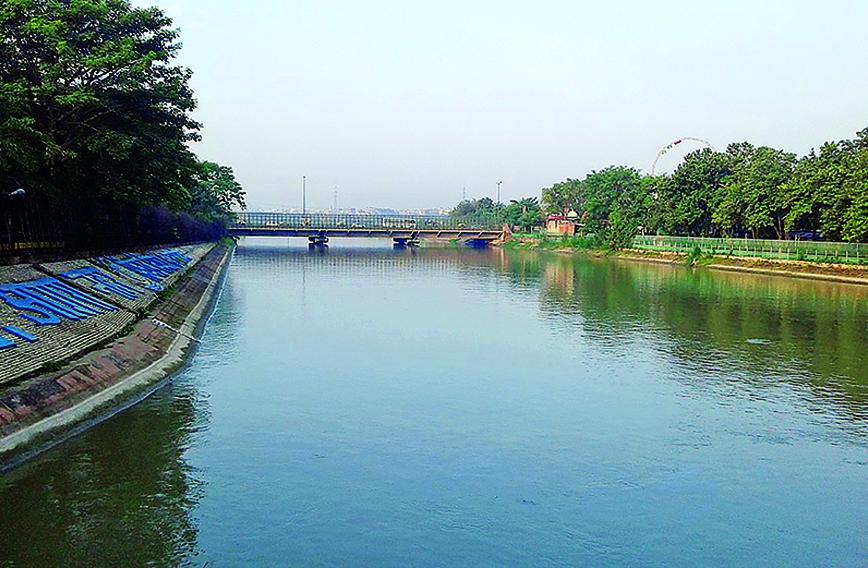
VENKATESH DUTTA
THE Yamuna river is showing some signs of improvement in its water quality. The levels of biological oxygen demand (BOD) in the Najafgarh drain evidenced a notable reduction of 33 percent, compared to the previous year, in May 2023. A lower BOD level signifies a decrease in organic pollutants and an overall healthier aquatic environment.
This drain contributes to approximately 70 percent of the wastewater discharge into the Yamuna in Delhi. The BOD value at Kashmere Gate dipped from 55 milligrams of oxygen per litre (mg/l) in May 2022 to 38 mg/l in May 2023. This indicates a positive trend in terms of improved water quality. However, the desirable value in a healthy river should be less than 3 mg/l. Therefore, a lot has to be done to see an appreciable improvement in water quality of the river. The most important step is to make all the Sewage Treatment Plants (STPs) functional and discharge fresh water into the river during the lean season.
In November 2021, Chief Minister Arvind Kejriwal announced a comprehensive six-point action plan aimed at addressing the fundamental issues impacting the Yamuna. The action plan includes connecting jhuggi-jhopri clusters to the sewer network, efficient tapping and diversion of drains, desilting of trunk sewers to remove accumulated sediments and debris, and upgradation of STPs to enhance their capacity and efficiency in treating wastewater. The action plan outlines crucial steps to tackle the challenges faced by the river, reflecting a commitment to its restoration and conservation.
Approximately 75 percent of the pollution in the Yamuna is concentrated within a short, 22-km segment, from Wazirabad to Okhla, receiving sewage from 16 drains. Remarkably, this relatively small portion represents less than 2 percent of the river’s total length, which extends approximately 1,376 km from Yamunotri to Allahabad. The river flows 54 km in Delhi from Palla to Badarpur after travelling nearly 400 km from its origin in Yamunotri. Throughout the dry season, which spans approximately nine months of the year, there is a lack of fresh water in the Yamuna downstream of Wazirabad. Instead, the only flow present consists of sewage, both treated and untreated. Moreover, pollution from the sugar and paper industries in Uttar Pradesh, which is carried through the severely polluted Hindon river, also adds to the contamination of the Yamuna.
Recently, the Central Monitoring Committee established by the National Green Tribunal (NGT) evaluated the initiatives of the Delhi government in maintaining the cleanliness of the Yamuna in Delhi. During the meeting, concerns were raised about industries operating in non-conforming areas. Additionally, the timelines for constructing new STPs and upgrading existing ones that do not meet the prescribed standards were also discussed. The deadline for completing the STPs at Rithala, Kondli and Okhla by June 2023 has not been met. The upgradation of non-compliant STPs to meet the prescribed standards by June 2024 is also a huge challenge.
A substantial portion of the sewage in Delhi is not being properly treated before being discharged into the Yamuna. Additionally, around 29 percent of the sewage generated in the city is not treated at all. Many STPs have been found to be non-compliant with the treatment standards set by the Delhi Pollution Control Committee (DPCC). Out of the 35 operational STPs, 22 were not meeting the prescribed standards for treating sewage. As a result, the partially treated water released from these STPs continues to pollute the Yamuna. In order to achieve desired levels of water quality of the river, it is essential to improve both the quality and capacity of STPs. Without these enhancements, major progress in improving the river’s water quality cannot be attained.
Currently, there are 1,797 unauthorized colonies in Delhi with a population of approximately seven million people. Additionally, there are 675 jhuggi clusters with a population of around three million people. Due to the lack of a proper sewerage network, a significant amount of sewage is released into natural stormwater drains. Ultimately, all these drains converge and flow into the Yamuna.
Untreated or partially treated sewage contains particles of soaps and detergents, oils, greases and surfactants that these STPs are unable to treat. The lean phase of the Yamuna river exacerbates the problem due to reduced water inflow and limited dilution of pollutants. The reduced water flow restricts the river’s ability to flush out pollutants effectively, affecting the natural self-purification capacity of the river. Without adequate water flow, the river struggles to maintain a healthy ecosystem and remove or disperse the pollutants effectively. As a result, the pollutants, including untreated sewage, industrial effluents, and other contaminants, remain in the water for a long time.
Can we bring back the Yamuna to its former glory? The answer is yes, provided we have a robust system of sewage management and freshwater inflows into the river. The untreated sewage and industrial effluents are pouring a variety of chemicals, heavy metals, and other pollutants into the river, posing serious threats to both human health and the ecosystem.
Reviving the Yamuna needs increased vigilance, strict regulation, enforcement of laws and proactive measures. Enhancing the quality of river water relies on two crucial factors: ensuring a minimum flow of fresh water and minimizing the discharge of polluted water, including both domestic and industrial waste, that enters the river.
Efforts to combat pollution in the river should be intensified on multiple fronts. Implementing strict wastewater treatment protocols, enhancing industrial regulations, and promoting sustainable waste management practices are crucial steps in mitigating pollution. The government and relevant authorities must work together to ensure that STPs are upgraded and operate efficiently, adhering to prescribed standards. Industries must be held accountable for treating their effluents before discharge, and regular monitoring and enforcement should be implemented. The floodplains along the Delhi and Uttar Pradesh stretch of the river should be designated as an environmentally sensitive zone for river conservation.
Venkatesh Dutta is a Gomti River Waterkeeper and a professor of environmental sciences at Ambedkar University, Lucknow
Comments
Currently there are no Comments. Be first to write a comment!




